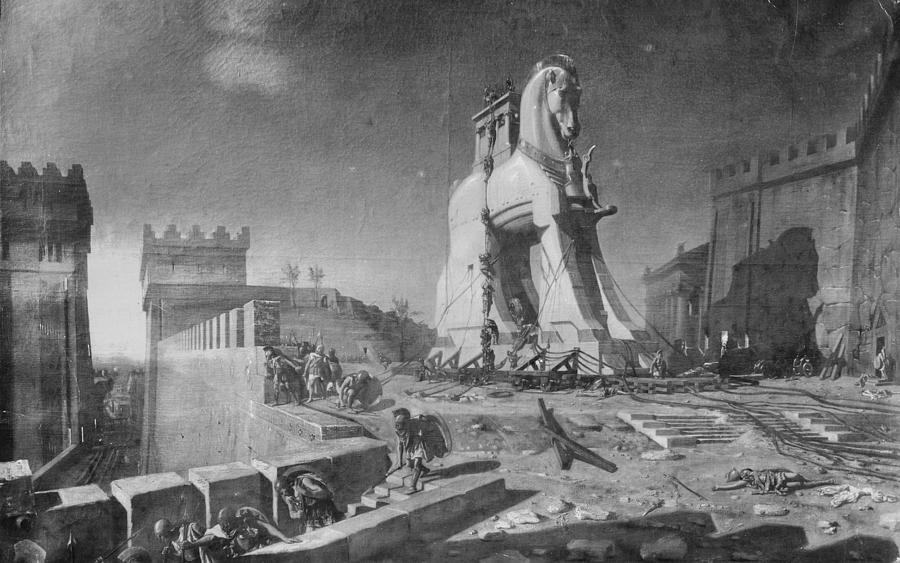The Trojan Horse. A colossal wooden beast, a symbol of cunning, and the key to Greek victory in the Trojan War. But was it real, or simply a fantastical element woven into the epic tale? This enduring question has captivated historians and storytellers for centuries.
Join us on a journey to explore the legend of the Trojan Horse. We’ll delve into the historical context of the Trojan War, analyze the lack of archaeological evidence for the giant horse, and explore various theories that attempt to unravel its true meaning.
Was it a metaphor for a siege engine? A symbolic representation of a cunning strategy? Or perhaps the story evolved from a simpler tale over time?
By exploring these questions, we’ll gain a deeper understanding of the Trojan Horse’s enduring legacy. It transcends its historical ambiguity to serve as a timeless symbol of deception, reminding us to be wary of appearances and the unexpected twists of fate.
The Trojan War’s Cunning End: Fact or Fiction?
The Trojan War, a legendary conflict immortalized in Greek epic poems, continues to capture our imagination. Images of fierce warriors like Achilles and Hector clashing on the battlefield are iconic, but perhaps the most enduring image is the one that brings victory to the Greeks: the colossal Trojan Horse.
But was the Trojan Horse real? This seemingly fantastical element of the story has sparked debate for centuries. The answer, as with many aspects of the Trojan War, lies somewhere between myth and potential historical truth.
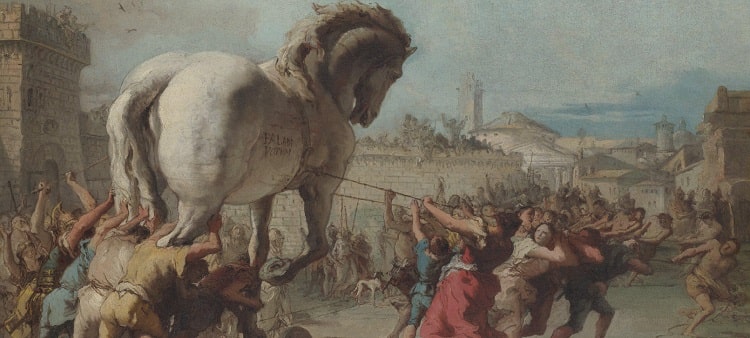
Our primary sources for the Trojan War are the epic poems, the Iliad and the Odyssey, attributed to the blind poet Homer. Composed sometime between the 8th and 7th centuries BC, these poems are not historical accounts, but rather poetic narratives that blend myth and legend with possible historical events. The Iliad focuses on a specific episode during the war, the rage of Achilles, while the Odyssey recounts the journey home of Odysseus, the mastermind behind the Trojan Horse strategy.
The story goes like this: After a grueling ten-year siege, the Greeks, frustrated and desperate, devised a cunning plan. Odysseus, known for his intellect and trickery, proposed building a giant wooden horse. Greek soldiers hid inside the hollow belly of the beast, while the remaining army pretended to sail away. Believing the war to be over, the Trojans enthusiastically brought the Trojan Horse within their city walls, celebrating their supposed victory.
Under the cover of night, the Greek soldiers emerged from the horse, wreaking havoc and ultimately securing victory for the Greeks. This dramatic climax, with its element of surprise and deception, is a cornerstone of the Trojan War legend.
But was the Trojan Horse real or simply a poetic invention? Historians remain divided. There is no archaeological evidence to support the existence of such a massive wooden structure.
Delving into the Trojan War: A Tale of Heroes and Fury
The legend of the Trojan Horse is undeniably captivating, but to understand its significance, we must delve into the epic saga of the Trojan War itself. This legendary conflict, believed to have occurred sometime in the late Bronze Age (roughly 12th-11th centuries BCE), pitted the Greeks, also known as Achaeans, against the Trojans. While the exact cause of the war remains shrouded in myth, several factors likely contributed to the rising tensions.
One popular explanation centers on Helen of Troy, a woman of unparalleled beauty married to Menelaus, king of Sparta. Paris, a Trojan prince, abducted Helen, sparking outrage among the Greeks. Menelaus, with the help of his brother Agamemnon, king of Mycenae, rallied a coalition of Greek city-states to reclaim Helen and avenge the insult.
The ensuing conflict became a clash of titans. Among the Greek heroes who sailed to Troy were Achilles, the “rage-filled” warrior with an almost impenetrable heel, and Odysseus, famed for his cunning intelligence. The Trojans, led by the mighty Hector, prince of Troy, fiercely defended their city.
The siege of Troy dragged on for a grueling ten years. The Iliad, our primary source for much of this information, focuses on a specific episode within this timeframe – the rage of Achilles. This epic poem, attributed to the blind poet Homer, offers vivid descriptions of battles, showcases the prowess of individual warriors, and explores themes of honor, glory, and the devastating cost of war.
Was the Trojan Horse real or simply a desperate measure born from this protracted conflict? The answer, as we’ll see, remains a topic of debate. The sheer length of the siege and the immense losses likely fueled the Greeks’ need for innovation and a creative solution, ultimately leading to the legendary Trojan Horse strategy.
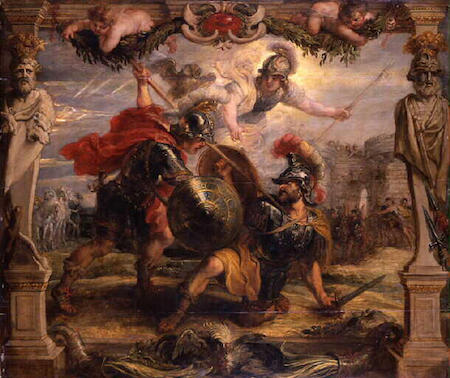
Another famous story that grapples with themes of war, heroism, and the afterlife is the story of Jesus of Nazareth. Did Jesus truly rise from the dead? This question, much like the question of the Trojan Horse’s reality, has sparked theological debate for centuries. To learn more about the historical and religious arguments surrounding the Resurrection of Jesus, check out our article.
The Wooden Deception: Unveiling the Trojan Horse Myth
The Trojan Horse stands as a powerful symbol of deception and cunning. The story, as recounted in the epic poem the Odyssey by Homer, revolves around the mastermind behind the plan – Odysseus, king of Ithaca. Frustrated by the seemingly endless siege, Odysseus proposed a daring strategy.
Greek artisans, under Odysseus’s direction, constructed a colossal wooden horse. The exact details of the horse’s size and appearance vary across different tellings. Some versions depict it as a fearsome beast, while others portray it as a more innocuous offering to the gods. Regardless of its specific form, the key element of the plan remained the same: a hollow belly that could conceal a contingent of Greek soldiers.
Once the horse was complete, the remaining Greek army seemingly sailed away, leaving the magnificent wooden structure behind. The Trojans, overjoyed at the apparent Greek retreat and eager to claim victory, debated the fate of the horse. Despite warnings, particularly from the Trojan priest Laocoön who famously declared “Beware of Greeks bearing gifts!” (a line Virgil added much later), the Trojans ultimately decided to bring the horse within their city walls.
Here, the story takes a dramatic turn. Under the cover of night, the hidden Greek soldiers emerged from the belly of the Trojan Horse. They overpowered the unsuspecting Trojans, opened the city gates for the returning Greek army, and unleashed chaos upon Troy. The ensuing slaughter and destruction marked the culmination of the ten-year war and the fall of Troy.
The story of the Trojan Horse has captivated audiences for millennia. It has been depicted in countless works of art, literature, and theater throughout history. But was the Trojan Horse real or simply a literary device employed by Homer? We’ll explore this question and the ongoing debate surrounding the Trojan Horse in the next section.
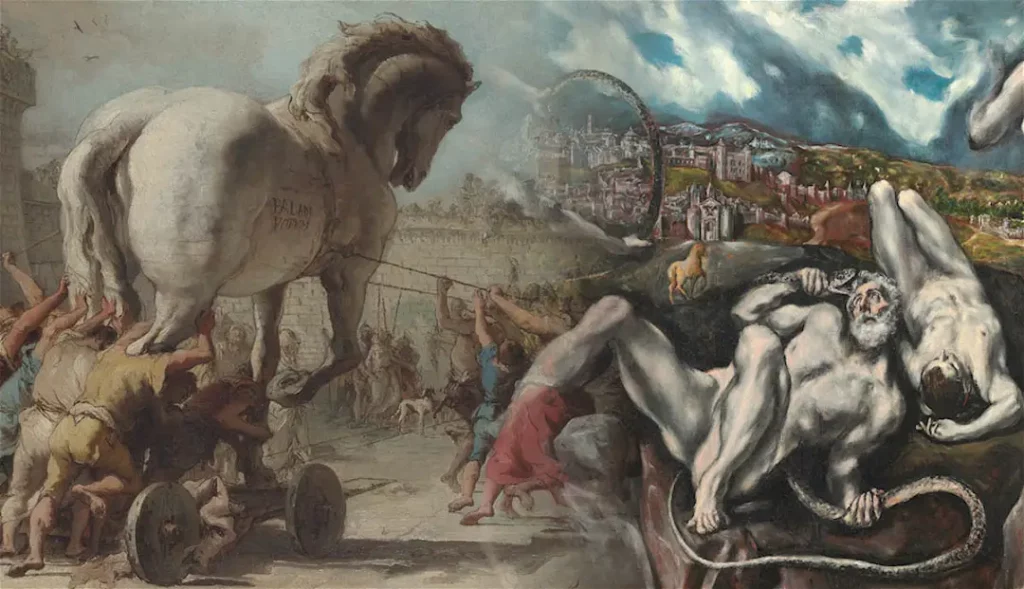
Beyond the Myth: Archaeological Insights
The legend of the Trojan Horse is undeniably captivating, but the question remains: is there any truth to this fantastical element of the story? While we haven’t unearthed a giant wooden horse during excavations, archaeological discoveries have shed light on the real city of Troy and the historical context of the Trojan War.
In the late 19th century, an enthusiastic amateur archaeologist named Heinrich Schliemann sparked a revolution in our understanding of the Trojan War. Guided by his belief in the literal truth of the Iliad, Schliemann began excavating a site in northwestern Turkey known as Hisarlik. After years of digging through layers of accumulated settlements, Schliemann unearthed a fortified city with impressive walls and evidence of a devastating fire. While the exact identification of Hisarlik as Troy remains a subject of some debate among scholars, most agree it represents a significant settlement from the Bronze Age, a period that coincides with the timeframe traditionally associated with the Trojan War.
Archaeological finds at Hisarlik and other nearby sites have provided valuable insights into the societies that may have been involved in the conflict. Fortifications, weaponry, and even depictions of warriors on pottery shards paint a picture of a bellicose era where warfare played a significant role. These discoveries don’t definitively prove the existence of a Trojan War, but they do lend credence to the possibility of a major conflict between powerful Bronze Age city-states.
Was the Trojan Horse real in the literal sense? The lack of archaeological evidence for such a colossal wooden structure suggests otherwise. However, some scholars propose alternative interpretations. Perhaps the Trojan Horse was a metaphor for a siege engine, or maybe the story reflects a real event where a group of attackers infiltrated a city by hiding inside a wooden structure.
The absence of a giant wooden horse doesn’t diminish the significance of the Trojan War legend. It serves as a powerful reminder of the human capacity for both ingenuity and deception. The story continues to resonate with us today, prompting us to question the nature of truth, the perils of war, and the enduring power of storytelling.
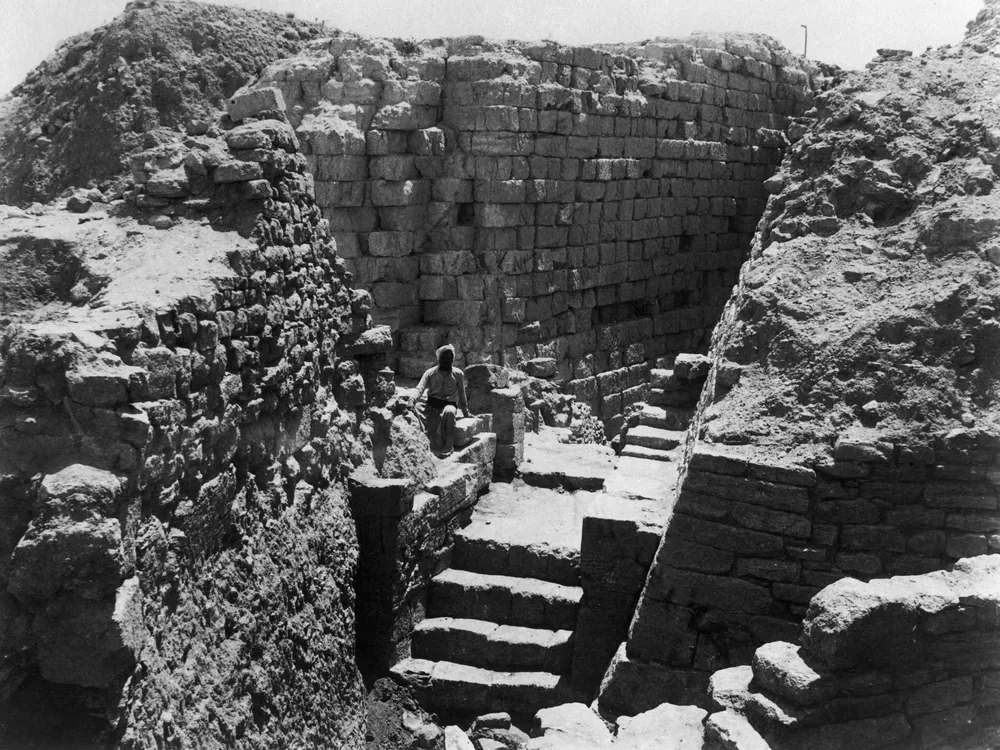
Unraveling the Enigma: Theories Behind the Trojan Horse
The enduring mystery surrounding the Trojan Horse continues to spark debate and ignite the imaginations of historians and storytellers alike. While the literal existence of a giant wooden horse seems improbable based on archaeological evidence, the story itself likely holds deeper meaning. Let’s explore some of the leading theories that attempt to unravel the enigma of the Trojan Horse.
Metaphorical Interpretation: Many scholars believe the Trojan Horse is not meant to be taken literally. It could be a powerful metaphor for a cunning strategy employed by the Greeks. Perhaps they used a real siege engine, such as a battering ram disguised as a horse, to breach the Trojan defenses. Alternatively, the story might represent the act of infiltrating the city through a hidden passage or by exploiting a weakness in the fortifications.
Dr. J. M. Cook, a renowned classicist, suggests the horse could symbolize an earthquake or a tidal wave sent by Poseidon, the Greek god of the sea and horses. This interpretation aligns with the destructive power attributed to the Trojan Horse and could explain the sudden collapse of the city’s defenses.
Siege Engine Inspiration: Another theory proposes a link between the Trojan Horse and actual siege engines used in warfare during the Bronze Age. These cumbersome structures were often constructed from wood and covered in animal hides for protection. Imagine a battering ram disguised as a horse, slowly approaching the city walls – this image might have morphed into the fantastical tale of the Trojan Horse over time.
Evolution of a Myth: It’s important to remember that the story of the Trojan War, as told in the Iliad and Odyssey, was likely passed down orally for centuries before being written down. Over time, details may have been embellished, and the original meaning could have been obscured. The Trojan Horse itself might have originated from a simpler story that evolved into the elaborate deception we know today.
The Enduring Legacy: Regardless of its historical accuracy, the Trojan Horse remains a potent symbol. It embodies the themes of deception, cunning, and the unexpected twists of fate that can turn the tide of war. The story serves as a cautionary tale, reminding us to be wary of seemingly harmless gifts and to remain vigilant against hidden dangers.

Legacy of the Trojan Horse: A Timeless Symbol of Deception
The Trojan War, a legendary conflict believed to have occurred during the late Bronze Age, has captured our imagination for millennia. The story’s climax – the Greeks emerging from the belly of a giant wooden horse to conquer Troy – is a powerful image of cunning and deception. But was the Trojan Horse real or simply a captivating invention woven into the epic narrative?
Archaeological discoveries, like the city of Troy unearthed by Heinrich Schliemann, provide valuable context for the Trojan War era. However, no evidence of a colossal wooden horse has been found. This lack of physical proof suggests the Trojan Horse may not be a literal account, but rather a symbolic representation with a deeper meaning.
Scholars have proposed various theories to unravel the enigma of the Trojan Horse. Some believe it’s a metaphor for a siege engine or a hidden strategy employed by the Greeks. Others suggest it reflects a simpler story that evolved into the elaborate deception we know today. The enduring mystery surrounding the Trojan Horse fuels its enduring power.
Regardless of its historical accuracy, the Trojan Horse has transcended its origins to become a universal symbol. It represents the dangers of deception, the element of surprise in warfare, and the potential for hidden dangers to lurk beneath seemingly harmless exteriors.
The image of the Trojan Horse continues to be referenced in popular culture, from literature and film to business and politics. It serves as a cautionary tale, reminding us to be critical of appearances and to remain vigilant against those who might employ cunning tactics to achieve their goals.
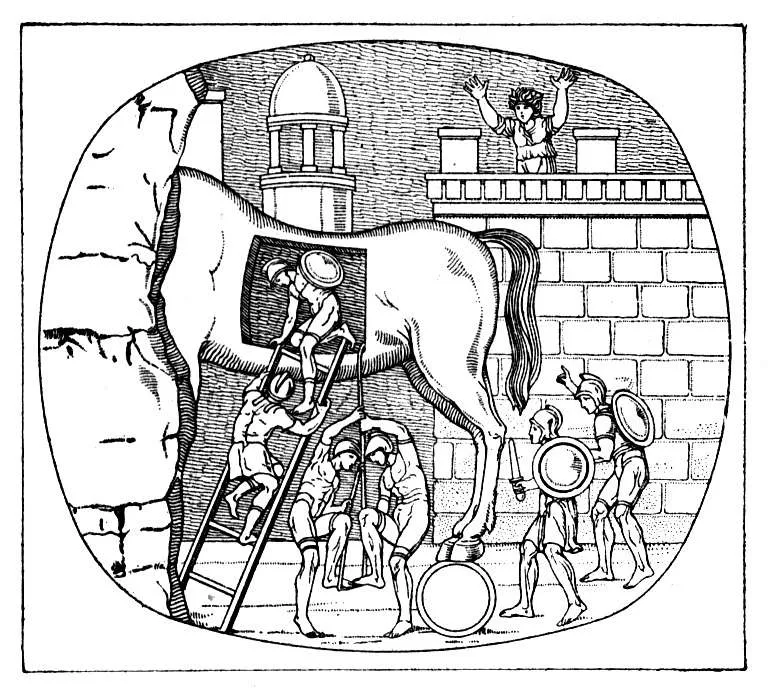
The question of whether the Trojan Horse was real may never be definitively answered. However, its legacy as a powerful symbol continues to resonate. If you’d like to delve deeper into the Trojan War and the mysteries surrounding it, here are some resources [insert links to relevant online resources about the Trojan War]. Perhaps you have your own theories about the Trojan Horse – feel free to share them in the comments below!
Frequently Asked Questions (FAQs)
1. Was the Trojan Horse a real historical event?
The archaeological evidence doesn’t support the existence of a giant wooden horse. However, the Trojan War itself is believed to be based on a real conflict that occurred during the late Bronze Age.
2. What are some theories about the Trojan Horse?
Scholars have proposed various interpretations. The horse could be a metaphor for a siege engine, a symbolic representation of a cunning strategy, or a story that evolved from a simpler account.
3. What is the legacy of the Trojan Horse?
Regardless of its historical accuracy, the Trojan Horse has become a powerful symbol of deception, surprise tactics, and the dangers of hidden threats.
4. Why don’t we have archaeological evidence of the Trojan Horse?
There are several reasons. Wood is a perishable material that decomposes quickly, especially outdoors. Additionally, Troy was a major city for centuries, with later settlements built on top of earlier ones. This makes it difficult for archaeologists to identify specific structures from the Trojan War era. However, the lack of a giant wooden horse doesn’t disprove the Trojan War itself. It simply suggests the story may be metaphorical or based on a different type of deception.
5. Was the Trojan Horse a believable tactic for the time period?
Deception was a common strategy in ancient warfare. There are accounts of other conflicts where attackers used disguises or infiltrated enemy cities through hidden passages. Additionally, the Trojan War’s ten-year siege likely led the Greeks to become desperate and innovative. While the giant wooden horse may be a fantastical element, it reflects a real possibility of the Greeks employing a cunning strategy to breach Troy’s defenses.
Use of Our Content
⚠️ Content on “Mystery Uncover” is protected under US and International Copyright Laws.
You are free to reuse, republish, and share our content by giving credit to the source as Mystery Uncover with a link to the original material on mysteryuncover.com.


